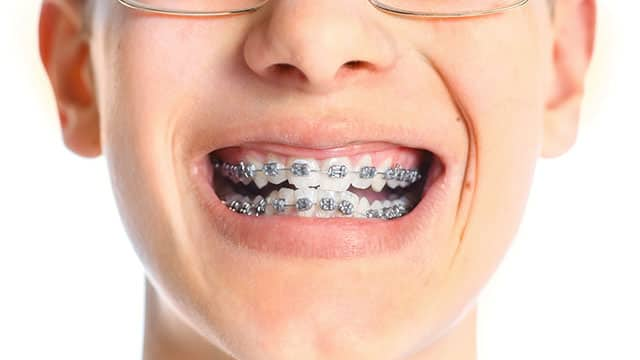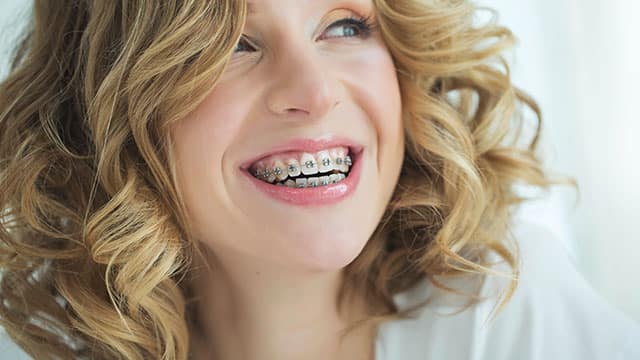Brushing and Flossing With Braces
Are you wondering how to take care of your braces? Proper dental care with braces is similar to your regular dental routine, but with difficulty dialed up slightly.
Removing food debris and plaque from your teeth is incredibly important and sometimes challenging with braces. There are more places for food to get stuck, and it can be hard to reach all the spots you need to clean. Plaque can build up around the brackets of your braces, leading to decay or gingivitis (inflammation of the gums). Luckily, proper care will help you avoid these issues.
Tips for your dental care routine with braces:
- Brush for two minutes twice daily and floss (or use other flossing devices) once daily to keep your mouth in top shape
- Be gentle when brushing and flossing to avoid damaging the brackets and wires.
- Consider using a floss threader to help make cleaning between your teeth easier.
- Use fluoride toothpaste or drink fluoridated water to strengthen your teeth.
- Rinse with mouthwash or mouth rinse to help remove debris
- Skip whitening toothpaste; it will not whiten the area behind your brackets and lead to a difference in your enamel's color upon removal of your braces.
Foods and Habits to Avoid
Changing habits can be challenging, but understanding healthier choices is a great first step in your journey. Braces present unique difficulty when consuming some foods, so doing your best to limit or cut them out entirely may be a great option.
Things to avoid to set yourself up for success:
- Avoid snacks like gum, popcorn, or corn on the cob, pretzels, and other messy foods that can get stuck.
- Skip sticky foods like caramels, gummies, and other candies
- Make an effort not to chew hard items that could damage your braces like ice, your nails or pens, and pencils.
- Don't smoke or use tobacco products.
Protecting Your Braces
Dental professionals often recommend wearing a mouthguard when you play sports or engage in activities with a risk of damage to your face or mouth. This step is uniquely important for those with braces as a hit to the face could harm your brackets, gums, or teeth.
Those without braces typically wear mouthguards for the top row of teeth. Your dentist or dental hygienist may recommend wearing a mouthguard on both rows of teeth to protect your mouth and braces. Talk to your dentist or orthodontist about getting a properly fitted mouthguard.
Troubleshooting Your Braces
Even with your best efforts and intention, things can go wrong with your braces. If you've incurred damage to your teeth or braces, it's vital to see a dental professional as soon as possible. Be careful not to swallow any broken items or try to fix anything yourself. It's best to trust the professionals when it comes to your health. Not to worry, they're prepared to help you.
Caring for Different Types of Braces
While taking care of all types of braces requires diligence and attention, there are some differences between available options to straighten teeth.
Ceramic Braces
Ceramic braces are like traditional braces; instead, they use clear or tooth-colored ceramic for the brackets (and sometimes wires).
The most significant difference in caring for these braces is that they're more likely to be discolored if neglected. Ceramic is more easily stained than stainless steel because it is porous. The tiny elastics or ligatures that connect the wires to the brackets are also susceptible to stains.
We recommend that you avoid items likely to cause stains like curry, meals heavy with tomatoes, red wine, or berries. Consult dental professionals about replacing any stained elastics.
Lingual Braces
Lingual is a word not everyone knows off the top of their head, but simply describes something near your tongue. Lingual braces are like the traditional type, but with the brackets and wires on the back of your teeth instead of the front.
Because of their location, lingual braces require special attention to ensure they're cared for correctly. We recommend cleaning thoroughly to avoid trapped food, plaque buildup, and damage. If you're not sure if you've damaged your lingual braces, make an appointment with your dental professional.
Clear Aligners
Caring for clear aligners require a unique approach simply because they're removable.
According to the American Association of Orthodontics, it would help if you avoided all drinks except tap water with your clear aligners. Liquids can get trapped and wear down your teeth or the aligner. If you remove your aligner to have a sugary or acidic drink, make sure to brush before replacing it.
Whatever type of braces you have, remember it's essential to follow proper dental hygiene and check in regularly with your dentist or orthodontist. You've made an excellent decision for your dental health, now's the perfect time to use that momentum to build healthy habits. Follow these tips you've learned about your braces, and you could be on your way to your dream smile!
This article is intended to promote understanding of and knowledge about general oral health topics. It is not intended to be a substitute for professional advice, diagnosis or treatment. Always seek the advice of your dentist or other qualified healthcare provider with any questions you may have regarding a medical condition or treatment.
ORAL HEALTH QUIZ
What's behind your smile?
Take our Oral Health assessment to get the most from your oral care routine
ORAL HEALTH QUIZ
What's behind your smile?
Take our Oral Health assessment to get the most from your oral care routine















